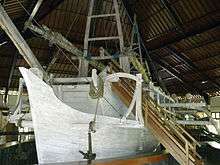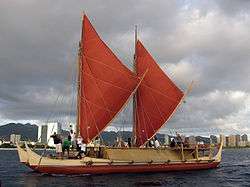Borobudur ship
A Borobudur ship is the 8th-century wooden double outrigger sailing vessel of Maritime Southeast Asia depicted in some bas reliefs of the Borobudur Buddhist monument in Central Java, Indonesia.[1] This has been designated as a World Heritage Site by UNESCO. The ships depicted on Borobudur were most likely the type of vessels used for inter-insular trades and naval campaigns by the Sailendran and Srivijayan thalassocracy empire that ruled the region around the 7th to the 13th century. The function of the outrigger was to stabilize the ship; a single or double outrigger canoe is the typical feature of the seafaring Austronesians vessels. It is considered by scholars to have been the most likely type of vessel used for their voyages and exploration across Southeast Asia, Oceania, and the Indian Ocean.
In the late 20th century, Philip Beale, a British sailor, became interested in depictions of the ship at Borobudur and decided to reconstruct one. Aided by government and international bodies, he organized an expedition team that constructed the ship and, from 2003 to 2004, sailed it from Indonesia to Madagascar and to Ghana, proving that long-distance trade could have occurred. The Samudra Raksa Museum was constructed at Borobudur Archeological Park to house the ship, opening in 2005, and provides other displays to interpret the ancient maritime history of Indonesians.
Borobudur ship expedition
Based on archeological and other evidence, scholars have learned that the bas reliefs of Borobudur depict the everyday life of 8th-century ancient Java, from courtly palace life to that of commoners in the village. An array of temple, marketplace, architecture, flora and fauna, dress, jewelry and fashion are portrayed, as well as modes of transportation including palanquins, horse carriages and ships.
In 1982, Philip Beale, a British sailor who previously served in the British Royal Navy, visited Borobudur to study traditional ships and marine traditions; he became fascinated with ten bas-relief images of ancient vessels depicted on Borobudur.[2] He planned to reconstruct this ancient ship and to reenact the ancient maritime trade route.[3] Working from very limited data — five stone carvings — but also his extensive naval experience, Beale organized an expedition team to reconstruct the ship and sail it from Jakarta in Indonesia to Madagascar, and then around the Cape of Good Hope to the west coast of Africa. He enlisted artisan experts and scholars in the effort.

Extensive research and design work preceded the building of the ship by a team of experienced Indonesian ship builders, based in the Kangean Islands some 60 miles north of Bali. Nick Burningham, an acknowledged expert on Indonesian watercraft and maritime archaeology, supervised the building of the vessel. The ship was built by Assad Abdullah al-Madani, a seasoned Indonesian traditional ship builder, and his men,[4] with little more than a balsa wood model that Burningham had created to help him. The vessel is named Samudra Raksa (defender of the seas) and was inaugurated in Benoa Harbor, Bali on 15 July 2003 by the Minister for Tourism and Culture of the Republic of Indonesia, I Gede Ardika, together with Philippe Delanghe, UNESCO Office Jakarta Program Specialist for Culture.
The keel is 17.29 m long and the hull is about 19 m overall with a beam of 4.25 m and moulded depth of 2.25 m. The sailing draft was approximately 1.5 m. The ship was propelled by two layar tanja (‘canted rectangular sails’). The hull planking was bungor (sometimes called ‘benteak’) and decks were teak.[5] The ship was not constructed with tall shields on the bow and stern like the reliefs because they obstructed the view to an extent that contravened Regulations for the Prevention of Collision at Sea.[6]
The expedition took place during the 6 months from August 2003 until February 2004. It started in Tanjung Priok harbour, Jakarta on 30 August 2003, launched by President Megawati Sukarnoputri, and arrived in the port of Tema, Accra, Ghana on 23 February 2004. The epic voyage demonstrated ancient trading links between Indonesia and Africa (in particular Madagascar and East Africa). Vessels traveled by what was historically called the "Cinnamon shipping route" from Indonesian waters across the Indian Ocean to the Seychelles, Madagascar, and then past South Africa to Ghana for trade.[7]
Today the Samudra Raksa is housed and displayed in Samudra Raksa Museum, located a few hundred meters north of Borobudur temple within the complex of Borobudur Archaeological Park. The Ship Museum Samudra Raksa was opened by Coordinating Minister for Welfare, Prof. Dr. Alwi Shihab of the Republic of Indonesia, on 31 August 2005. It was a tribute to the crew and all who worked with and supported the Borobudur Ship Expedition.
On stamps
This style ship has been memorialized on stamps: one image from the bas-relief on the temple, and the other to commemorate the Borobudur Ship Expedition of 2003-2004.
Plate renderings
Renderings of the five ships with outriggers in the Borobudur bas-reliefs (out of seven ships depicted in total) in Conradus Leemans' Boro-Boedoer (1873). Note that the ships are of different types.[8]
Replica
- The well known replica is housed at Samudra Raksa museum, Magelang, Central Java, Indonesia.
- One replica is moored on Marine March of Resorts World Sentosa dock in Singapore.[9]
- Borobudur relief serve as the basis for constructing "Spirit of Majapahit", a replica of Majapahit ship. This replica has received criticism from historians, because the ship used by Majapahit is jong while the Borobudur relief ship is a Srivijayan and Sailendran vessel.[10]
- A replica of Borobudur ship was featured in the opening ceremony of the Asian Games 2018 on 18 August 2018 in Gelora Bung Karno Stadium, Jakarta.[11]
In popular culture
- Borobudur ship and ship carving are featured in the Age of Empires II expansion pack, Rise of the Rajas.
- Borobudur ship serve as the basis for the model of Majapahit Jong in video game Civilization VI, with double outriggers, double quarter rudders, and rowers.
See also
- Karakoa
- Kora kora
- K'un-lun po (kolandiaphonta), a type of vessel used in the archipelago as early as 1st century A.D.
Notes
- Naʻalehu Anthony (September 25, 2015). "The Borobudur Temple Ship: Bringing a Memory Back to Life". National Geographic. Retrieved 3 November 2015.
- Grice, Elizabeth (17 March 2004). "A strange kind of dream come true". The Telegraph. Retrieved 3 November 2015.
- Sean Woods (4 March 2004). "Sailing the Cinnamon Route". IOL. Retrieved 3 November 2015.
- Abriansyah, Taufik. "Ekspedisi Borobudur : Napak Tilas Memperkaya Batin". Majalah Gatra. Retrieved 3 December 2019.
- Beale, Philip (April 2006). "From Indonesia to Africa: Borobudur Ship Expedition". Ziff Journal: 22 – via http://www.swahiliweb.net/ziff_journal_3_files/ziff2006-04.pdf.
- Schottenhammer, Angela (2019). Early Global Interconnectivity across the Indian Ocean World, Volume II. Switzerland: Palgrave Macmillan. p. 186. ISBN 978-3-319-97801-7.
- Peter Janssen (15 September 2003). "Borobudur Ship Follows Ancient Spice Route". Arab News. Retrieved 3 November 2015.
- Haddon, A.C. (1920). The Outriggers of Indonesian Canoes. London, Royal Anthropological Institute of Great Britain and Ireland.
- "I ship it! Historic Ship Harbour at RWS". S.E.A. Aquarium at Resorts World Sentosa. 2014-06-04. Retrieved 2018-07-29.
- "Replika Kapal Majapahit, Replika Untuk Menghancurkan Sejarah Bangsa – Nusantara Review". www.nusantarareview.com. Retrieved 2020-04-30.
- Pak Dosen (2018-08-18), Opening Ceremony Asian Games 2018 - Jakarta Palembang, 9:14, retrieved 2018-08-26
References
- Pareanom, Yusi Avianto (2005). Cinnamon Route, The Samudraraksa Borobudur Expedition. Yogyakarta: PT. Taman Wisata Candi Borobudur, Prambanan & Ratu Boko, Ministry of Culture and Tourism of Republic of Indonesia, Lontar Foundation. ISBN 978-979-8083-58-7.
External links
Note: The following two links are dead. Could someone help please?
- "The Cinnamon Route". Borobudur Park. 2011. Archived from the original on 2012-04-07. Retrieved 2011-10-24.
- "The Cinnamon Route (web archive link)". Borobudur Temple (within this section). Borobudur, Prambanan & Ratu Boko. 2011. Archived from the original on 2014-07-01. Retrieved 2011-10-24.
- "From Indonesia to Africa - Borobudur Ship Expedition." Philip Beale. 2006.pdf Retrieved 3 November, 2015


.png)
.png)
.png)
.png)
.png)


.jpg)